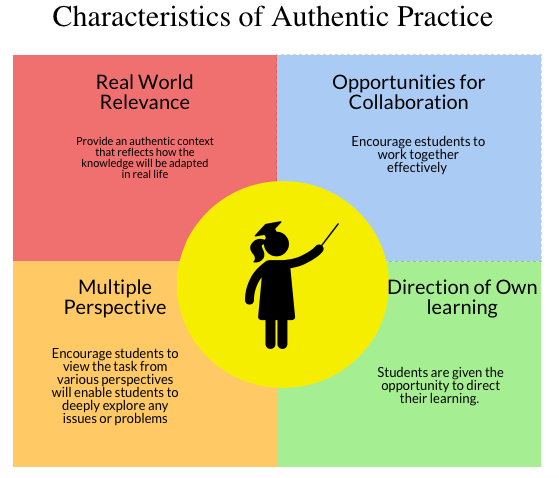It is important to us, as educators, to
get our students to be excited about learning and engaged in learning.
But how do we do it? This is where
Authentic Practice comes into play.
So…What is Authentic Practice?
Surrounds the idea that educators
provide opportunities and appropriate support for students so they are able to
engage in self-directed problem solving, discussion, critical thinking, and
reflections in real world contexts (Maina, 2004). Studies have shown that when students are exposed to
authentic learning activities, they become more engaged (Maina, 2004) The more
authentic a task is, the more a student is likely to show engagement of
concepts learnt and are more likely to retain the information (Herrington,). Linking content with
student’s real lives, as seen in authentic practice, has shown to create a
favorable learning environment for students (Alvermann, Gillis and Phelps, 2013).
Herrington and Herrington’s (2005) highlights of the
important characteristics of authentic learning have been adapted in figure 1
below.
 |
| Figure 1. Adapted from Herrington and Herrington (2005) |
It is evident that we as educators
should encourage the adaption of an authentic practice pedagogy in the
classroom as it is beneficial in incorporating numeracy and literacy in the
curriculum (Kalantzis and
Cope, 2016).
Using Authentic
Practice in Science to Teach Literacy and Numeracy
“Explore Genetics by Family Traits!” Is an activity by Education.com
(n.d) that has been adapted into figure 2. It is a great example of how we as
science teachers can use authentic learning to engage students through
activities as well as teach the literacy and numeracy aspects of science.
How do we know this
task is authentic?
The task includes characteristics outlined in figure 1.
- -The task relevant to the real world through the use of
using the family to determine traits.
-
Opportunities to collaborate are evident as students must
collaborate with family members interviewed to determine answers to the
questions.
-
Students are encouraged to view physical perspectives
from different family members.
-
Direction of own learning is taken on by student as they
must complete most of the task outside of school.
You may be wondering how the activity “Exploring Genetics Through Family
Traits” teaches the literacy and numeracy aspects of science.
A main capability of the Science Curriculum is Questioning and Inquiry
skills as stated by the Australian Curriculum, Assessment and Reporting
Authority (2018). This capability is evident in the above activity as students
are required to interview their family members about their physical traits.
This develops their questioning and enquiry skills.
Science Literacy skills such as the ability to formulate questions that
can be investigated scientifically are developed in this task as students had
to ask questions that were later to be interpreted scientifically (ACARA, 2018). As well as this,
the literacy aspect of using scientific knowledge to draw conclusions
consistent with evidence is developed as students were asked to interpret the
data and conclude whether genes were recessive or dominant, through the use of
learned scientific knowledge.
As well as this, Scientific Numeracy skills are evident in the task. For
example, students were asked to use analyse patterns and trends in data by
looking at the results of their findings and determining relationships within
their results to reach conclusions (ACARA, 2018). Numeracy skills are
also evident when collecting data and inputting them into a table.
It is important that we as teachers adapt authentic learning activities
such as the example above to encourage active student engagement in the
classroom as well as further develop their literacy and numeracy skills.
References
References
Alvermann, D.,
Phelps, S., & Gillis, V. (2013). Content area reading and literacy.
Boston: Pearson.
Australian
Curriculum, Assessment and Reporting Authority (2018b). Science. Retrieved from
https://www.australiancurriculum.edu.au/f-10-curriculum/science/?year=12010&strand=Science+Understanding&strand=Science+as+a+Human+Endeavour&strand=Science+Inquiry+Skills&capability=ignore&capability=Literacy&capability=Numeracy&capability=Information+and+Communication+Technology+%28ICT%29+Capability&capability=Critical+and+Creative+Thinking&capability=Personal+and+Social+Capability&capability=Ethical+Understanding&capability=Intercultural+Understanding&priority=ignore&priority=Aboriginal+and+Torres+Strait+Islander+Histories+and+Cultures&priority=Asia+and+Australia’s+Engagement+with+Asia&priority=Sustainability&elaborations=true&elaborations=false&scotterms=false&isFirstPageLoad=false
Cope, B., &
Kalantzis, M. (2009). “Multiliteracies”: New Literacies, New Learning.
Pedagogies: An International Journal, 4(3), 164-195. http://dx.doi.org/10.1080/15544800903076044
Explore genetics by
finding family traits. (n.d) Retrieved from
https://www.education.com/activity/article/Family_Genes_middle/
Herrington, A., &
Herrington, J. (2005). Authentic learning environments in higher education.
Retrieved from https://books.google.com.aubooks?hl=en&lr=&id=WSC9AQAAQBAJ
&oi=fnd&pg=PR7&dq=authentic+learning+environments+in+higher+education&ots=Op9dqDBH_c&sig=JCy9TcQx97egepeg5kGzpc7o0cE#v=onepage&q=authentic%20learning%20environments%20in%20higher%20education&f=false
Maina, Faith.
(2004). Authentic Learning: Perspectives from Contemporary Educators. Journal of Authentic Learning. Retrieved
from
https://www.researchgate.net/publication/26413481_Authentic_Learning_Perspectives_from_Contemporary_Educators

Comments
Post a Comment